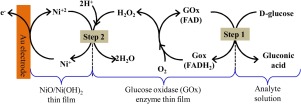当前位置:
X-MOL 学术
›
Colloids Surf. B Biointerfaces
›
论文详情
Our official English website, www.x-mol.net, welcomes your
feedback! (Note: you will need to create a separate account there.)
Bioelectrocatalysis and surface analysis of gold coated with nickel oxide/hydroxide and glucose oxidase towards detection of glucose.
Colloids and Surfaces B: Biointerfaces ( IF 5.4 ) Pub Date : 2020-03-16 , DOI: 10.1016/j.colsurfb.2020.110981 Nqobile Njoko 1 , Marcel Louzada 1 , Jonathan Britton 2 , Samson Khene 1 , Tebello Nyokong 2 , Philani Mashazi 2
Colloids and Surfaces B: Biointerfaces ( IF 5.4 ) Pub Date : 2020-03-16 , DOI: 10.1016/j.colsurfb.2020.110981 Nqobile Njoko 1 , Marcel Louzada 1 , Jonathan Britton 2 , Samson Khene 1 , Tebello Nyokong 2 , Philani Mashazi 2
Affiliation

|
The fabricating of metal oxide thin films onto conducting surfaces continues to grow and their potential applications as surfaces for biosensor applications is of paramount importance. The correct orientation of glucose oxidase redox enzymes yields very important biointerfaces capable of selectively detecting d-glucose as a measure of blood sugar for healthy and diabetic sick patients. The electrodeposition of redox enzymes, such as glucose oxidase enzymes, onto gold electrode surfaces pre-modified with nickel oxide was investigated in this work. The surface characterization confirmed the chemical nature, morphology and thin film composition of the modification of bare and modified gold electrodes. The electrodeposition of GOx enzyme onto nickel oxide/hydroxide thin film resulted in a surface with excellent bioelectrocatalytic properties towards the detection of d-glucose. The nickel within the nickel oxide/hydroxide thin film had a Ni(II) oxidation state. A well-defined redox peak of GOx enzyme co-factor (FAD/FADH2) was observed confirming the oriented immobilization onto NiO/Ni(OH)2 conducting surfaces. The amount of GOx enzyme deposited was determined by integrating the charge (Q = 0.368 μF) under the reduction peak and the surface coverage was found to be 1.43 × 10-10 mol. cm-2. A linear plot of electrocatalytic reduction currents against d-glucose concentrations was obtained up to 30.0 mM with a linear correlation coefficient (R2) of 0.99. The limit of detection (LoD) using S/N = 3 was calculated to be 1.54 ± 0.03 mM. The sensitivity of the biosensors was 1.95 ± 0.13 μA.mM.cm-2. The selectivity towards only d-glucose and not ascorbic acid and uric acid was evaluated and the Au-NiO/Ni(OH)2-GOx could not detect 1.0 mM of ascorbic acid and uric acid.
中文翻译:

氧化镍/氢氧化物和葡萄糖氧化酶涂覆的金的生物电催化和表面分析,用于检测葡萄糖。
金属氧化物薄膜在导电表面上的制造继续增长,其作为生物传感器应用表面的潜在应用至关重要。葡萄糖氧化酶氧化还原酶的正确方向会产生非常重要的生物界面,能够选择性地检测d-葡萄糖,以测量健康和糖尿病患者的血糖水平。在这项工作中,研究了氧化还原酶(例如葡萄糖氧化酶)在用氧化镍预修饰的金电极表面上的电沉积。表面表征证实了裸电极和修饰金电极的修饰的化学性质,形态和薄膜组成。GOx酶在氧化镍/氢氧化镍薄膜上的电沉积导致表面具有出色的生物电催化特性,可检测d-葡萄糖。氧化镍/氢氧化镍薄膜中的镍具有Ni(II)氧化态。观察到GOx酶辅助因子(FAD / FADH2)的明确定义的氧化还原峰,证实了在NiO / Ni(OH)2导电表面上的定向固定。通过在还原峰下积分电荷(Q = 0.368μF)来确定GOx酶的沉积量,表面覆盖率为1.43×10-10 mol。厘米2。获得了高达30.0 mM的线性电催化还原电流对d-葡萄糖浓度的线性图,线性相关系数(R2)为0.99。使用S / N = 3的检测限(LoD)计算为1.54±0.03 mM。生物传感器的灵敏度为1.95±0.13μA.mM.cm-2。评价了仅对d-葡萄糖而不对抗坏血酸和尿酸的选择性,并且Au-NiO / Ni(OH)2-GOx无法检测到1.0 mM的抗坏血酸和尿酸。
更新日期:2020-03-16
中文翻译:

氧化镍/氢氧化物和葡萄糖氧化酶涂覆的金的生物电催化和表面分析,用于检测葡萄糖。
金属氧化物薄膜在导电表面上的制造继续增长,其作为生物传感器应用表面的潜在应用至关重要。葡萄糖氧化酶氧化还原酶的正确方向会产生非常重要的生物界面,能够选择性地检测d-葡萄糖,以测量健康和糖尿病患者的血糖水平。在这项工作中,研究了氧化还原酶(例如葡萄糖氧化酶)在用氧化镍预修饰的金电极表面上的电沉积。表面表征证实了裸电极和修饰金电极的修饰的化学性质,形态和薄膜组成。GOx酶在氧化镍/氢氧化镍薄膜上的电沉积导致表面具有出色的生物电催化特性,可检测d-葡萄糖。氧化镍/氢氧化镍薄膜中的镍具有Ni(II)氧化态。观察到GOx酶辅助因子(FAD / FADH2)的明确定义的氧化还原峰,证实了在NiO / Ni(OH)2导电表面上的定向固定。通过在还原峰下积分电荷(Q = 0.368μF)来确定GOx酶的沉积量,表面覆盖率为1.43×10-10 mol。厘米2。获得了高达30.0 mM的线性电催化还原电流对d-葡萄糖浓度的线性图,线性相关系数(R2)为0.99。使用S / N = 3的检测限(LoD)计算为1.54±0.03 mM。生物传感器的灵敏度为1.95±0.13μA.mM.cm-2。评价了仅对d-葡萄糖而不对抗坏血酸和尿酸的选择性,并且Au-NiO / Ni(OH)2-GOx无法检测到1.0 mM的抗坏血酸和尿酸。









































 京公网安备 11010802027423号
京公网安备 11010802027423号